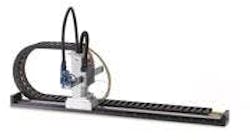3-Axis SCARA Robot
3-Axis SCARA Robot In an effort to advance palletizing applications that do not require the traditional SCARA (Selective Compliance Assembly Robot Arm) system’s 4-axis design, WEISS has designed an economically advanced 3-axis design solution. Traditional, tried-and-true SCARA robots remain a very popular solution for palletizing and tray packing applications. However, their typical design configuration features four axes consisting of two rotary axes and one lifting swivel unit?which is generally not needed for most palletizing applications. The bottom line is, there’s no need to invest in 4 axes for the application. In terms of figures, a SCARA robot costs on average around $13,000?therefore the end-user pays roughly $3,250 per axis. On average, the WEISS handling axes cost the same?but only three are required. This results in a figure of approximately $9,750 for a handling system that covers a working space of 70 x 225 x 200 mm. Additionally, the WEISS 3-axis solution allows for an additional modular swivel unit to be used where necessary. Ultimately, 4-axis SCARA robots typically have one axis too many for a lot of applications, can be costly, and take too long to program?especially when simpler and more economical alternatives like WEISS’ 3-axis intelligent system is available. The major advantage of WEISS’ 3-axis system is that end-users only pay for what they actually need. Thus, procurement costs for the three axes are significantly lower when compared with a 4-axis SCARA. The key to this intelligent handling solution relies on standard components that have been proven in thousands of applications and can be combined to create perfectly matched sub-systems. For this specific palletizing example, WEISS selected a type HN 100 linear motor axis as the basic axis. Permanently connected to the basic axis is the HP series direct-drive pick & place module? which forms the 2nd and 3rd axis (see Figure I below). Unlike a SCARA robot, the strokes of the axes can be precisely matched to the dimensions of the tray. Vital efficiency advantages in the assembly process also come to the forefront when comparing the work process of the two concepts. The operating range of a SCARA robot is limited to a semi-circle in front of it?however, the standardized DIN pallet is always rectangular. This means the SCARA robot is often seen with only three pallets, which just fit into its working range. This semicircular arrangement then makes it extremely difficult to achieve linear 'advancing' of the pallets within a fully automated assembly process?as is the norm in modern, flowing conveyor belt production processes. Furthermore, once pallets of different sizes come into play, the system has severe difficulties. A square pallet simply does not fit in with a curved robot action radius (see Figure II below). As a result, manual intervention is often the only option which may include: relocating, rearranging, or completely exchanging the pallets.
- Price: $9,75
- Working Space: 70 x 225 x 200 mm
